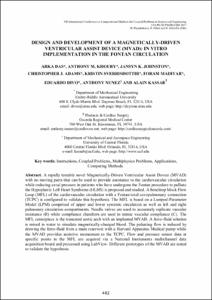Mostra el registre d'ítem simple
Design and development of a magnetically-driven ventricular assist device (MVAD): in vitro implementation in the fontan circulation
| dc.contributor.author | Das, Arka |
| dc.contributor.author | Khoury, Anthony M. |
| dc.contributor.author | Johnston, Jansyn K. |
| dc.contributor.author | Adams, Christopher J. |
| dc.contributor.author | Sverrisdottir, Kristin |
| dc.contributor.author | Madiyar, Foram |
| dc.contributor.author | Divo, Eduardo |
| dc.contributor.author | Nunez, Anthony |
| dc.contributor.author | Kassab, Alain |
| dc.date.accessioned | 2020-06-12T08:44:44Z |
| dc.date.available | 2020-06-12T08:44:44Z |
| dc.date.issued | 2017 |
| dc.identifier.isbn | 978-84-946909-2-1 |
| dc.identifier.uri | http://hdl.handle.net/2117/190578 |
| dc.description.abstract | A rapidly testable novel Magnetically-Driven Ventricular Assist Device (MVAD) with no m ving parts that can be used to provide assistance to the cardiovascular circulation while reducing caval pressure in patients who have undergone the Fontan procedure to palliate the Hypoplastic Left Heart Syndrome (HLHS) is proposed and studied. A benchtop Mock Flow Loop (MFL) of the cardiovascular circulation with a Fontan total cavopulmonary connection (TCPC) is configured to validate this hypothesis. The MFL is based on a Lumped-Parameter Model (LPM) comprised of upper and lower systemic circulation as well as left and right pulmonary circulation compartments. Needle valves are used to accurately replicate vascular resistance (R) while compliance chambers are used to mimic vascular compliance (C). The MFL centerpiece is the truncated aortic arch with an implanted MVAD. A ferro-fluid solution is mixed in water to simulate magnetically-charged blood. The pulsating flow is induced by drawing the ferro-fluid from a main reservoir with a Harvard Apparatus Medical pump while the MVAD provides assistive momentum to the TCPC. Flow and pressure sensor data at specific points in the MFL are acquired via a National Instruments multichannel data acquisition board and processed using LabView. Different prototypes of the MVAD are tested to validate the hypothesis. |
| dc.format.extent | 9 p. |
| dc.language.iso | eng |
| dc.publisher | CIMNE |
| dc.subject | Àrees temàtiques de la UPC::Matemàtiques i estadística::Anàlisi numèrica::Mètodes en elements finits |
| dc.subject.lcsh | Finite element method |
| dc.subject.lcsh | Coupled problems (Complex systems) -- Numerical solutions |
| dc.subject.other | Instructions, Coupled Problems, Multiphysics Problems, Applications, Computing Methods |
| dc.title | Design and development of a magnetically-driven ventricular assist device (MVAD): in vitro implementation in the fontan circulation |
| dc.type | Conference report |
| dc.subject.lemac | Elements finits, Mètode dels |
| dc.rights.access | Open Access |
| local.citation.contributor | COUPLED VII |
| local.citation.startingPage | 482 |
| local.citation.endingPage | 490 |


